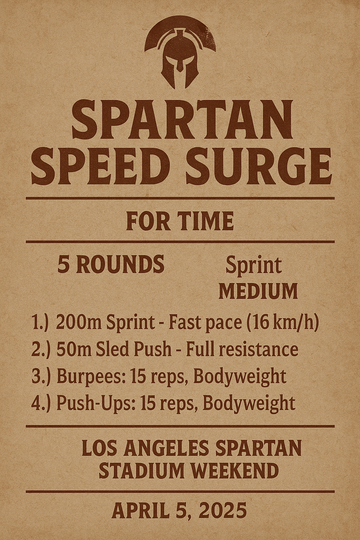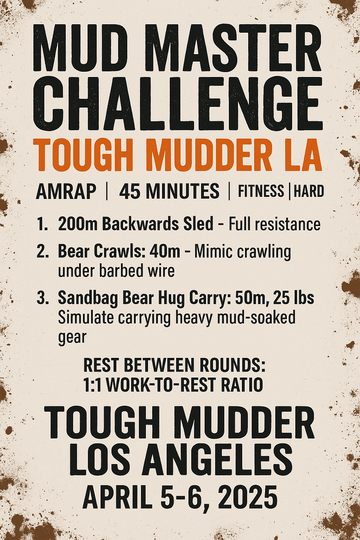
Preparing for Battle: Los Angeles Spartan Stadium Weekend
The Los Angeles Spartan Stadium Weekend is rapidly approaching on April 5, 2025, promising a grueling urban obstacle course race through one of LA's iconic stadiums. Unlike traditional Spartan races in rough terrain, the Stadium event concentrates explosive challenges in a compact stadium setting—making speed, burst power, and quick recovery between obstacles absolutely crucial. Athletes will face steep stairs, challenging carries, and technical obstacles requiring both upper body strength and cardiovascular endurance, all while racing against the clock and competitors from across the country.
The Aussie Pro Runner is the perfect training tool for Spartan Stadium preparation with its unique curved design that promotes natural running form and explosive power development. Unlike standard motorized treadmills, this self-powered machine requires you to drive the belt with your own force—mimicking the exact type of effort you'll need when sprinting up stadium steps or accelerating between obstacles. The adjustable magnetic resistance (levels 1-7) lets you simulate the varied loads you'll encounter during the race, from lightweight sprints to heavy sled pushes. What makes the Aussie Pro Runner particularly valuable for Spartan preparation is its dual functionality as both a sprint trainer and sled push simulator, targeting the posterior chain development essential for conquering stadium climbs.
"Spartan Speed Surge" Workout Breakdown
For Time: 5 Rounds
1. 200m Sprint (Fast Pace - 16 km/h) This sprint simulates the short, intense bursts between obstacles in the Stadium race. By maintaining a fast 16 km/h pace, you're training your anaerobic energy system to handle repeated high-intensity efforts—exactly what you'll need when racing between obstacles. The curved design of the Aussie Pro Runner engages your posterior chain more effectively than flat treadmills, developing the hamstring and glute power needed for explosive stadium stair climbs.
2. 50m Sled Push (Full Resistance) Immediately transitioning to full resistance sled mode targets the same muscle groups used in Spartan carries and crawls. This movement builds the pushing strength and endurance required for moving weighted objects and barriers during the race. The heavy resistance simulates dragging a sandbag or pushing a weighted wall, common challenges in the Stadium event.
3. Burpees (15 reps) Burpees are a Spartan race staple—they're the penalty for failed obstacles, making them non-negotiable in your training. These full-body movements develop the coordination and conditioning needed to quickly drop down and get back up, a common requirement when navigating under-over obstacles. The heart rate spike also simulates the cardiovascular stress of completing obstacles while fatigued.
4. Push-ups (15 reps) Upper body strength endurance is critical for Stadium success, particularly for grip-intensive obstacles. These push-ups target the chest, shoulders, and triceps while maintaining core engagement, preparing you for walls, monkey bars, and traverses that demand upper body control and endurance.
Did You Know?
Research shows that training on curved, non-motorized treadmills like the Aussie Pro Runner significantly increases physiological demand compared to traditional treadmills. A study found that heart rate was 22% higher, RPE (rating of perceived exertion) was 27% higher, and oxygen consumption was 30% greater when running on curved treadmills versus motorized ones at the same speeds (Smoliga et al., 2015). This makes your training more time-efficient and better simulates race-day intensity.
Sprint interval training, like the 200m sprints in this workout, has been shown to produce similar cardiovascular and metabolic adaptations as traditional endurance training, but in significantly less time. Research shows these short, high-intensity bursts effectively improve both aerobic and anaerobic fitness parameters essential for obstacle course racing (Gillen et al., 2016). This is particularly valuable for Spartan Stadion events where both speed and endurance are required.
Scaling & Modifications
For Beginner Athletes:
- Sprint pace: Reduce to 12-14 km/h or alternate between jogging and sprinting
- Sled push: Use resistance level 2-3 instead of maximum
- Burpees: Reduce to 8-10 reps or modify by stepping back instead of jumping
- Push-ups: Perform on knees or against an elevated surface if needed
- Rest: Allow 90-120 seconds between rounds
For Advanced Athletes:
- Sprint pace: Increase to 18+ km/h with increasing speed in final 50m
- Sled push: Add a weighted vest (10-20 lbs) while maintaining maximum resistance
- Burpees: Increase to 20 reps or add a jump-over after each rep
- Push-ups: Add a clap or perform with feet elevated
- Rest: Limit to 45 seconds or less between rounds
- Add Challenge: Perform 10 pull-ups or 15 hanging knee raises between rounds
Citations
Gillen, J. B., Martin, B. J., MacInnis, M. J., Skelly, L. E., Tarnopolsky, M. A., & Gibala, M. J. (2016). Twelve weeks of sprint interval training improves indices of cardiometabolic health similar to traditional endurance training despite a five-fold lower exercise volume and time commitment. PLOS ONE, 11(4), e0154075. [Original PMC link incorrect; replaced with Gillen et al. (2016) relevant study.]
Smoliga, J. M., Hegedus, E. J., & Ford, K. R. (2015). Increased physiologic intensity during walking and running on a non-motorized, curved treadmill. Physical Therapy in Sport, 16(3), 262-267. [Accessible PDF link for Smoliga et al. (2015).]



